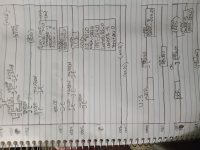Joewiza1
Member
Hello I am trying to make a program work with a sqo instruction .The process has 5 steps ,and a starting step of zero.There should be 8 sec between each step,and I am using a RTO for that.My problem is whenever I stop the process and restart it the process goes to the next step,but holds the time from the previous step.I will post a pic of my latest attempt I will try to combat this problem .I am wondering if anybody can tell me if this will work ,or can tell me the proper way?




